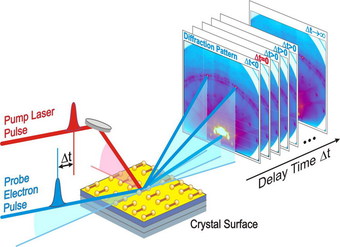PGI Colloquium:
Prof. Dr. Michael Horn-von Hoegen,Department of Physics, University of Duisburg-Essen, Duisburg, Germany
PGI Lecture Hall, Building 04.8, 2nd Floor, Room 365
- begin
- 12 Jun 2015 11:00
Electron diffraction at surfaces: now ultrafast!
The dynamics of ultrafast structural phenomena at surfaces are studied using electron diffraction with a combination of a pulsed electron gun with a fs laser system in a pump probe scheme under ultra-high vacuum conditions. The grazing incidence of electrons of 7 – 30 keV in reflection high energy electron diffraction (RHEED) geometry ensures high surface sensitivity. The sample is excited with 800 nm photons with pulses of 80 fs length, energy of 1 mJ at 5 kHz repetition rate and a fluence of 1 – 8 mJ/cm2. By applying a tilted pulse front scheme for the laser pulses, the temporal resolution of the entire setup has recently been improved to less than 400 femtoseconds!
 Copyright: Prof. Dr. von Hoegen
Copyright: Prof. Dr. von Hoegen
The huge potential of this technique is demonstrated with the non-equilibrium dynamics of the In induced (8x2) reconstruction on Si(111). This surface exhibits a Peierls-like phase transition at 130 K from a (8x2) ground state, which is accompanied by the formation of a charge density wave (CDW), to a (4x1) excited state. Upon excitation by the fs-laser pulse, the (8x2) ground state is driven into the excited (4x1) state at a sample temperature of 30 K. The surface is only excited electronically; the CDW is lifted by photo doping in less than 400 fs, but the surface remains for almost one nanosecond in a super-cooled excited (4x1) high temperature state.
An activation barrier of ~40 meV for the collective motion of the In atoms hinders the immediate recovery of the (8x2) ground state. This metastable situation – a hidden state of matter far away from equilibrium – is only accessible through the ultra-fast excitation by the fs-laser pulse. Relaxation to the (8x2) ground state is delayed on a timescale of tau ~ 500 picoseconds and is triggered by remnant (8x2) areas pinned at adsorbates that act as nucleation seeds in the same way that super-cooled water in a bottle freezes upon the insertion of seeds. The surface unit cells fall back into their ground state, one at a time, like a row of falling dominoes. The phase front propagates at about 100 m/s.


